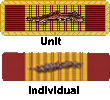

The various medals awarded during combat operations reflect specific degrees of unit and/or an individual soldier's performance.
Presidential Unit Citation
The 1st Infantry was awarded the Presidential Unit Citation for its role at Maffin Bay during WWII with the Americal Division. The Presidential Unit Citation, originally called the Distinguished Unit Citation, is awarded to units of the Armed Forces of the United States and allies for extraordinary heroism in action against an armed enemy on or after 7 December 1941 (the date of the Attack on Pearl Harbor and the start of American involvement in World War II). The unit must display such gallantry, determination, and esprit de corps in accomplishing its mission under extremely difficult and hazardous conditions so as to set it apart from and above other units participating in the same campaign.
The degree of heroism required is the same as that which would warrant award of the Distinguished Service Cross, Air Force Cross or Navy Cross to an individual. In some cases, one or more individuals within the unit may have also been awarded personal recognitions for their contribution to the actions for which their entire unit was awarded a "Distinguished Unit Citation" as it was initially known. The present name of Presidential Unit Citation was received on November 3rd, 1966. Since its inception by Executive Order No. 9075 the Presidential Unit Citation has been awarded in such conflicts as World War II, Korean War, Vietnam War, Iraq War, Afghanistan War and the Cold War. As with other Army unit citations, the PUC is in a larger frame that is worn above the right pocket. All members of the unit may wear the decoration, whether or not they personally participated in the acts for which the unit was cited.
Philippine Presidential Unit Citation
The Philippine Presidential Unit Citation was awarded for World War II service in the Philippines in 1944–1945 during the liberation from Japanese control. All members and former members of the 1st Infantry Regiment are authorized to wear the citation.
Valorous Unit Award
The 1st Infantry Regiment has been awarded 2 VUA's; one for Quang Tin Province actions in Vietnam in August, 1969 while part of the 196th LIB, and one for the Iraq from 2005-2006 while assigned to the 172nd Stryker Brigade. The Valorous Unit Award is the second highest unit decoration which may be bestowed upon a U.S. Army unit (the highest being the Presidential Unit Citation) and is considered the unit equivalent of the Silver Star. It is awarded to units of the United States Army which display extraordinary heroism in action against an armed enemy of the United States of America.
The Valorous Unit Award is to be awarded to units of the Armed Forces of the United States for extraordinary heroism in action against an armed enemy of the United States while engaged in military operations involving conflict with an opposing foreign force or while serving with friendly foreign forces engaged in an armed conflict against an opposing armed force in which the United States is not a belligerent part for actions occurring on or after 3 August 1963. The Valorous Unit Award requires a lesser degree of gallantry, determination, and esprit de corps than that required for the Presidential Unit Citation. Nevertheless, the unit must have performed with marked distinction under difficult and hazardous conditions in accomplishing its mission so as to set it apart from the other units participating in the same conflict. The degree of heroism required is the same as that which would warrant award of the Silver Star to an individual. Extended periods of combat duty or participation in a large number of operational missions, either ground or air, is not sufficient. This award will normally be earned by units that have participated in single or successive actions covering relatively brief time spans. It is not reasonable to presume that entire units can sustain Silver Star performance for extended time periods under the most unusual circumstances. Only on rare occasions will a unit larger than a battalion qualify for this award.
Meritorious Unit Commendation
The 23rd Infantry Division was awarded the Meritorious Unit Commendation for it's outstanding service in either World War II and/or Vietnam. As of this date, I have not been able to find the specifics of the award and any help would be appreciated. Any information may be Emailed to the webmaster of this site. All units of the 23rd Infantry Division (Americal) are eligible to wear this ribbon.
The Meritorious Unit Commendation is awarded to units for exceptionally meritorious conduct in performance of outstanding services for at least six continuous months during the period of military operations against an armed enemy occurring on or after 1 January 1944. Service in a combat zone is not required, but must be directly related to the combat effort. The unit must display such outstanding devotion and superior performance of exceptionally difficult tasks as to set it apart and above other units with similar missions. The degree of achievement required is the same as that which would warrant award of the Legion of Merit to an individual. Only in rare cases will a unit larger than a battalion qualify for award of this commendation. For services performed during World War II, awards will be made only to service units and only for services performed between 1 January 1944 and 15 September 1946. Effective 1 March 1961, the Meritorious Unit Commendation was authorized for units and/or detachments of the Armed Forces of the United States for exceptionally meritorious conduct in performance of outstanding services for at least six continuous months in support of military operations. Such service is interpreted to relate to combat service support type activities and not to the type of activities performed by senior headquarters, combat, or combat support units.
Vietnam Cross of Gallantry with Palm

The Vietnam Gallantry Cross was a military decoration of South Vietnam which was established in August 1950. Also known as the Vietnamese Cross of Gallantry, the Gallantry Cross was awarded to any military personnel who have accomplished deeds of valor or displayed heroic conduct while fighting an enemy force. It was modeled after the French Croix de guerre. The Gallantry Cross was issued in four degrees, with a basic medal followed by higher degrees which were the equivalent of personal citations on an organizational level. The degrees of the Gallantry Cross were as follows: Gallantry Cross with Palm (Individual Award), Gallantry Cross with Gold Star (Corps citation), Gallantry Cross with Silver Star (Division citation), and Gallantry Cross with Bronze Star (Regiment or Brigade citation). The Vietnam Gallantry Cross also was issued as a unit award which is an entirely separate decoration from the full sized medal. The Unit Citation was issued to every military unit of the United States Army which had served under the Military Assistance Command from 1961 to 1974. Regulations for the issuance of the Vietnam Gallantry Cross permit the wearing of both the individual and unit award simultaneously, since they both are considered separate decorations. The 2nd Battalion, 1st Infantry Regiment was awarded the "Cross with palm" on 4 separate occasions, See: Awards Page. All members of the 2nd Battalion, 1st Infantry Regiment who served in Vietnam are entitled to the Gallantry Cross with Palm (both ribbon and medal) and the unit award. Only the unit award may be worn by non-Vietnam members.
The National Personnel Records Center is the agency which responds to retroactive award requests, from U.S. Army veterans, updating military records to show the Vietnam Gallantry Cross Unit Citation, either per Army General Order 8 or per unit specific awards (See "Related Links" Page for National Archives). The decoration itself, both full medal and unit citation, are considered foreign military decorations and are not provided to Vietnam veterans by any of the United States military services. The decoration is available for purchase at most Military Installations military clothing sales. But if they are unable to access a military installation, private military insignia dealers have them on hand. The decoration may also be found for sale on the Internet.